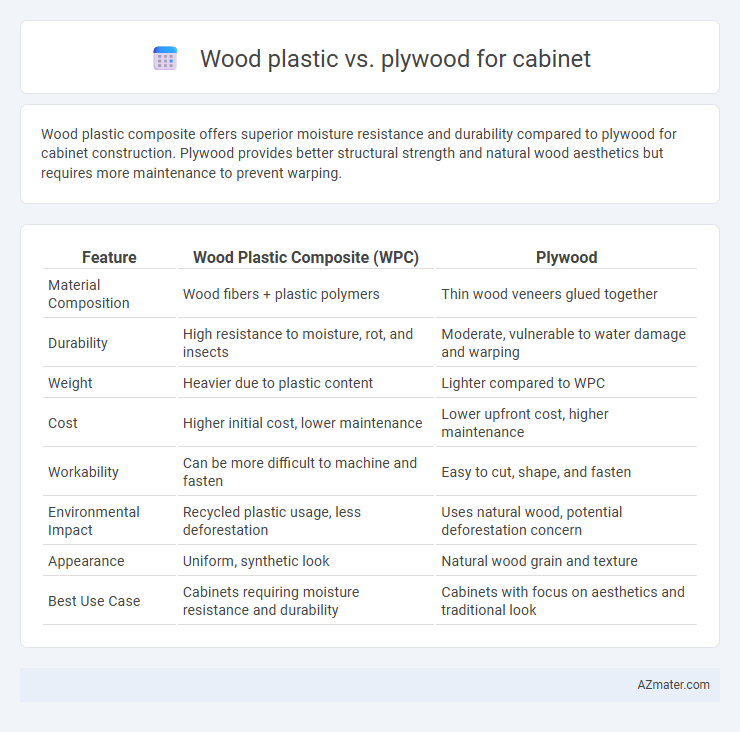Wood plastic composite offers superior moisture resistance and durability compared to plywood for cabinet construction. Plywood provides better structural strength and natural wood aesthetics but requires more maintenance to prevent warping.
Table of Comparison
| Feature | Wood Plastic Composite (WPC) | Plywood |
|---|---|---|
| Material Composition | Wood fibers + plastic polymers | Thin wood veneers glued together |
| Durability | High resistance to moisture, rot, and insects | Moderate, vulnerable to water damage and warping |
| Weight | Heavier due to plastic content | Lighter compared to WPC |
| Cost | Higher initial cost, lower maintenance | Lower upfront cost, higher maintenance |
| Workability | Can be more difficult to machine and fasten | Easy to cut, shape, and fasten |
| Environmental Impact | Recycled plastic usage, less deforestation | Uses natural wood, potential deforestation concern |
| Appearance | Uniform, synthetic look | Natural wood grain and texture |
| Best Use Case | Cabinets requiring moisture resistance and durability | Cabinets with focus on aesthetics and traditional look |
Introduction to Cabinet Material Choices
Wood plastic composite (WPC) and plywood are two popular cabinet materials offering distinct advantages in durability and aesthetics. WPC combines wood fibers with plastic, providing moisture resistance and low maintenance, ideal for kitchens and bathrooms. Plywood, made from thin wood veneer layers, offers superior strength and a natural wood appearance, preferred for traditional cabinetry and customization.
What is Wood Plastic Composite?
Wood Plastic Composite (WPC) is a manufactured material combining wood fibers and thermoplastics, offering enhanced durability and resistance to moisture compared to plywood. Unlike plywood, which is made from thin layers of wood veneer glued together, WPC provides superior dimensional stability and requires less maintenance in high-humidity environments. This makes WPC a popular choice for cabinets in areas prone to moisture, such as kitchens and bathrooms.
Understanding Plywood for Cabinetry
Plywood for cabinetry consists of multiple layers of wood veneer glued together, offering superior strength and stability compared to solid wood. Its cross-grain construction minimizes warping and provides a durable surface for cabinets in kitchens and bathrooms. High-quality plywood resists moisture and impacts, making it a preferred choice for long-lasting, structurally sound cabinetry.
Durability: Wood Plastic vs Plywood
Wood plastic composites (WPC) offer superior resistance to moisture, insects, and rot compared to plywood, making them more durable in humid or wet environments. Plywood, while strong and versatile, tends to delaminate and warp when exposed to prolonged moisture, reducing its lifespan in kitchen or bathroom cabinetry. WPC's combination of wood fibers and plastic provides enhanced structural stability and longer-lasting performance under varying environmental conditions.
Moisture and Water Resistance Comparison
Wood plastic composites (WPC) offer superior moisture and water resistance compared to plywood, making them ideal for cabinets in high-humidity environments. Plywood, while structurally strong, tends to absorb water and swell, leading to warping and delamination over time. The synthetic polymers in WPC create a water-repellent barrier, preventing moisture infiltration and extending the lifespan of cabinetry in kitchens and bathrooms.
Cost Analysis: Which is More Budget-Friendly?
Wood plastic composites (WPC) typically cost more upfront than plywood due to manufacturing and material composition but offer long-term savings through durability and low maintenance. Plywood is initially more budget-friendly, with prices ranging from $30 to $50 per sheet, making it suitable for cost-sensitive projects. Factoring in lifespan and resistance to moisture and pests, WPC can be more economical over time despite higher initial costs.
Ease of Installation and Workability
Wood plastic composites (WPC) offer greater ease of installation for cabinets due to their lightweight nature and resistance to warping, making them simpler to drill, cut, and fasten compared to plywood. Plywood, composed of multiple wood veneers, provides superior workability with better screw holding strength and easier sanding for a smooth finish, but it is more prone to splintering and can be heavier to handle. Both materials require proper tools, but WPC's moisture resistance enhances durability during installation in humid environments, reducing post-installation adjustments.
Aesthetics and Design Flexibility
Wood plastic composites (WPC) offer sleek, modern aesthetics with a consistent texture and customizable colors, making them ideal for contemporary cabinet designs. Plywood provides a natural wood grain appearance that enhances traditional and rustic styles, and can be easily stained or painted to match various interior decor themes. WPC allows greater design flexibility by enabling complex shapes and moisture-resistant finishes, whereas plywood excels in strength and can be crafted into detailed, classic cabinet structures.
Environmental Impact and Sustainability
Wood plastic composites (WPC) for cabinets offer enhanced durability and resist moisture, reducing the need for frequent replacements and lowering environmental waste. Plywood is biodegradable and sourced from natural wood, but its production often involves deforestation and the use of formaldehyde-based adhesives that can impact indoor air quality. Choosing WPC made from recycled plastics supports waste reduction and promotes circular economy practices, while sustainably sourced plywood certified by FSC ensures responsible forest management.
Which Material is Best for Your Cabinets?
Wood plastic composites (WPC) offer superior moisture resistance and durability compared to plywood, making them ideal for kitchen and bathroom cabinets exposed to humidity. Plywood provides natural strength, easier customization, and a classic wood grain appearance preferred in traditional cabinetry. For long-lasting, low-maintenance cabinets, wood plastic is best, while plywood suits projects prioritizing natural aesthetics and ease of woodworking.

Infographic: Wood plastic vs Plywood for Cabinet
 azmater.com
azmater.com